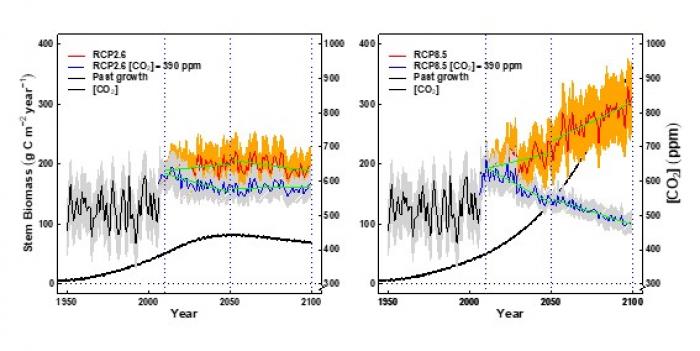Guillermo Gea-Izquierdo (OT-Med post-doc)
J. Guiot (CEREGE)
W. Cramer, F. Guibal (IMBE)
A. Nicault (ECCOREV)
Forest performance is challenged by climate change but higher atmospheric [CO2] (ca) could help trees mitigate the negative effect of enhanced water stress. Forest projections using data assimilation with mechanistic models are a valuable tool to assess forest performance. Using model simulations of future forest growth, we addressed the following questions: (i) What will be the net effect of a warmer climate for Mediterranean forests? (ii) To what extent could rising atmospheric CO2 concentration help compensate the expected negative effect of climate warming on forest growth and productivity? (iii) How will Mediterranean forests perform in relation to the maximum temperature threshold for future climate (i.e., +2.0 °C respect to preindustrial levels) of the Paris Agreement.
We used dendrochronological data from 12 Mediterranean tree species (six conifers and six broadleaves) to calibrate a process-based vegetation model at 77 sites. And we conducted simulations of gross primary production (GPP) and radial growth using an ensemble of climate projections for the period 2010–2100 for the high-emission RCP8.5 and low-emission RCP2.6 scenarios. GPP and growth projections were simulated using climatic data from the two RCPs combined with (i) expected ca; (ii) constant ca = 390 ppm, to test a purely climate-driven performance excluding compensation from carbon fertilization. The model accurately mimicked the growth trends since the 1950s when, despite increasing ca, enhanced evaporative demands precluded a global net positive effect on growth. Modelled annual growth and GPP showed similar long- term trends. Under RCP2.6 (i.e., temperatures below +2 °C with respect to preindustrial values), the forests showed resistance to future climate (as expressed by non-negative trends in growth and GPP) except for some coniferous sites. Using exponentially growing ca and climate as from RCP8.5, carbon fertilization overrode the negative effect of the highly constraining climatic conditions under that scenario. This effect was particularly evident above 500 ppm (which is already over +2 °C), which seems unrealistic and likely reflects model miss-performance at high ca above the calibration range. Thus, forest projections under RCP8.5 preventing carbon fertilization displayed very negative forest performance at the regional scale. This suggests that most of western Mediterranean forests would successfully acclimate to the coldest climate change scenario but be vulnerable to a climate warmer than +2 °C unless the trees developed an exaggerated fertilization response to [CO2].
Example of growth projections at one Quercus pyrenaica site. Trends (i.e. linear regressions between mean growth and year) for 2010-2050, and 2051-2099 are shown with green lines for the ‘fertilization’ (red line) and ‘non-fertilization’ (blue line) scenarios. Shaded areas behind annual mean growth values (thick black line is mean past growth) correspond to the confidence intervals for the mean . 'ca' values ([CO2]) corresponding to the two scenarios considered (i.e. RCP2.6, RCP8.5) are shown as thin black lines. From Gea-Izquierdo et al, 2017.



